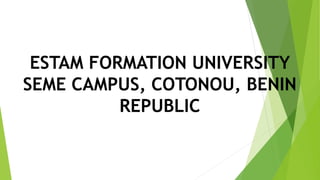
GSM SECURITY
- 1. ESTAM FORMATION UNIVERSITY SEME CAMPUS, COTONOU, BENIN REPUBLIC
- 2. UCHENNA RAPHAEL UCHECHUKWUKA FACULTY OF ENGINEERING DEPARTMENT OF COMPUTER ENGINEERING 200 LEVEL
- 4. WHAT IS GSM? The Global System for Mobile Communication Communication (GSM) is a standard to describe the protocols for second-generation (2G) digital cellular networks used by mobile devices such as mobile phones and tablets. BENEFITS OF GSM 1. Emergency responses 2. Technological growth 3. Universal data transfer 4. Has international capabilities
- 5. WHAT IS GSM SECURITY GSM security is provided for gsm network subscribers to communicate securely without any intrusion. The security here is covered for the air interface part and not for the fixed network part. The air interface is considered to be weakest for the hackers. Security for SS7 part was not provided as SS7 was used for few of the institutions.
- 6. The GSM security mechanism is covered with following; *Authentication (used for billing purposes) *Confidentiality *Anonymity(used to identify users) *PIN lock, EIR, personalization, etc. *Authentication process helps gsm network authenticate the right user. This authentication procedure in gsm security mechanism is triggered due to following; 1. On the access to the network 2. Accessing the network for the purpose of making or receiving calls 3. Location update process and the change of subscriber-related information stored in HLR
- 7. WHAT IS ACCESS CONTROL? Access control is a fundamental fundamental component of data security that dictates who’s allowed to access and use company information and resources. Through authentication and authorization, access control policies make sure users are who they say they are and that they have appropriate access to company data. Access control can also be applied to limit physical access to campuses, buildings, rooms and data centers.
- 8. TYPES OF ACCESS CONTROL There are two types of access control. They are; 1. Physical access control 2. Logical access control 1.PHYSICAL ACCESS CONTROL Physical access control systems are used in homes or organizations to authorise or deny entry to their premises. It grants access to employees and contractors who work at or visit a site by electronically authenticating their PIV credentials. Physical access control limits access to buildings, compounds, warehouses, rooms, etc. 2. LOGICAL ACCESS CONTROL A logical access control system requires the validation of an individual’s identity through some mechanism such as a PIN, biometric or other token. It has the capability to assign different access privileges to different individuals depending on their roles and responsibilities in an organization.
- 9. How does access control work? Access control identifies users by verifying various login credentials, which can include usernames and passwords, PINs, biometric scans and security tokens. Many access control systems also include multifactor authentication (MFA) a method that requires multiple authentication methods to verify a user identity. Once a user is authenticated, access control then authorizes the appropriate level of access and allowed actions associated with that user credentials and IP address.
- 10. Why is access control important? Access control keeps confidential information such as customer data, personally personally identifiable information, and intellectual property from falling into the wrong hands. It’s a key component of the modern zero trust security framework, which uses various mechanisms to continuously verify access to the company network. Without robust access control policies, organizations risk data leakage from both internal and external sources. Access control is particularly important for organizations with hybrid cloud and and multi-cloud environments, where resources, apps, and data reside both on premises and in the cloud. Access control can provide these environments with more robust access security beyond single sign-on (SSO) and prevent unauthorized access from unmanaged and BYO devices.
- 13. CONCLUSION In the fields of physical security and information security, access control is the selective restriction of access to a place or other resources, while access management describes the process. The act of accessing may mean consuming, entering, or using. Permission to access a resource is called authorization.
- 14. THANK YOU